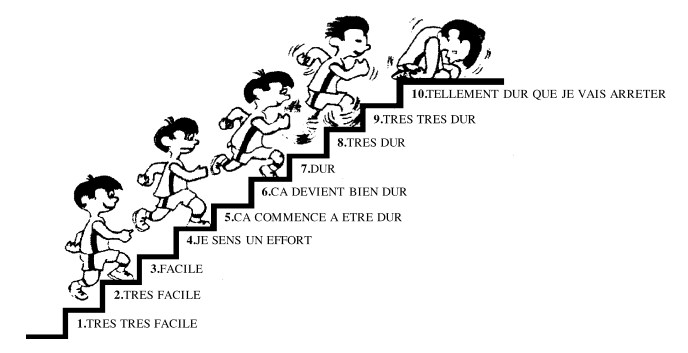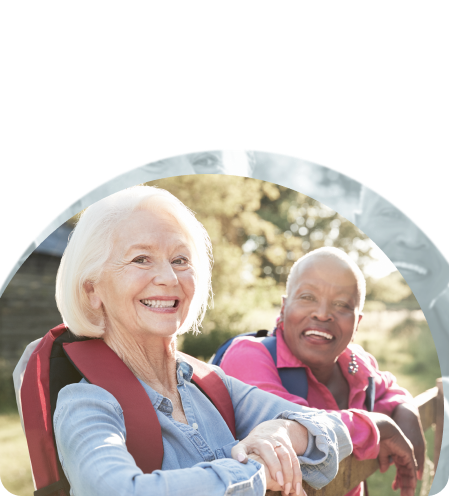
You’ve probably wondered this before, and that’s okay. In this time of confinement, it’s important to keep moving and being physically active, but no one should be doing anything, anyhow. Some do group workouts online, others train on their own at home, but for both of them, knowing the intensity at which you are doing it is essential to determine if this is appropriate. It is possible, even without a specific device, to measure this intensity yourself, using a scale called “perception of effort”. This is important because it allows everyone to challenge themselves to enjoy the benefits of physical activity while respecting their limits in order to avoid injury or overtraining.
Measuring the perception of effort
A very easy-to-use tool for measuring perception of effort during physical activity is the Borg scale. It was designed to allow a person to give a subjective rating to how they feel during exercise, by rating their perceived exertion on a scale of 1 to 10 (there is also a version of this scale on 20). This involves noting the sensations during exercise, the amount of effort required, for example, to use the arms or legs, or difficulty in breathing. This can be manifested by feelings of heat, tiredness, shortness of breath, or difficulty executing a movement.

From Coquart et al. 2009 (French translation of the Child’s Effort
Perception Scale (CERT) from Williams et al. 1994)
For the same exercise, the perception of effort may be different from one individual to another. This is quite normal since the sensations are different. They depend on several factors, including physical condition, physical activity habits, current level of fatigue or energy, the presence of illness, etc. For example, a person accustomed to running and in good physical condition may have to move at 10 km / h to reach a perception of effort of 6/10 while his neighbor, who is in less good condition physical, could perceive the same effort of 6/10 while moving at 4 km / h. This means that the perception of effort is not a measure of performance, but a measure of difficulty. This is why it is important to respect your own limits, to listen to your body and to go at your own pace, not that of others.
The link with the guidelines for physical activity
As you’ve probably heard before, the World Health Organization recommends that all adults, including the elderly and those living with illnesses, get 150 minutes of moderate to vigorous physical activity per week. What does it mean? Should we all start jogging tomorrow morning? Of course not. Here is how we can translate this intensity on a perceived exertion scale from 1 to 10 to categorize the exercises performed.
Light intensity (2-3): This corresponds to exercise performed at a very slow pace with little exertion. There is little or no shortness of breath and sweating. This is a level of intensity that can be achieved by performing activities of daily living, such as quietly walking inside or outside the house, cleaning or gardening. A “Neuro Flexibility” session is a good example of light intensity physical activity.
Moderate intensity (4-5): The exercise is moderately difficult. Your breathing is faster than at rest. You can speak, but not sing. You are hot and you are sweating a little. This is a level of intensity one can feel when doing a physical activity like brisk walking or climbing stairs, but it does not require the same amount of effort for everyone. Moderate intensity is the one desired during the “Movements on chairs” and “Neuro Balance” sessions.
High / vigorous intensity (6-7): Physical activity is difficult. You are breathing fairly quickly and you are sweating a lot. This is what we want to achieve during an “Adapted Boxing” training and a “Neuro Intensity” session. You can also get this intensity when jogging, walking on inclines, hiking in the mountains or cycling, but it depends on each person. A walk around the block can take a lot of effort for one person and very little for another.
Very high / very vigorous intensity (8-10): At this type of intensity, you give your maximum. It’s a very difficult exercise. It is impossible to maintain this intensity for a long period of time. Breathing is difficult and sweating profuse. A good example of very high intensity is a running sprint, but it can be achieved otherwise by repeatedly jumping without a break or by swimming a pool length at maximum speed. However, for some individuals, the mere act of climbing the stairs may require near maximum effort, which is why it is important to refer to your own sensations.
For some people, the feeling of being short of breath, sweating and hot is uncomfortable and can sometimes even be scary. However, it should be remembered that it is possible to achieve moderate or high intensity, but the way to get there will not be the same. Also, to get used to these sensations, it is possible to increase the level of intensity of the workouts gradually over the weeks. That being said, if you are not used to exercising at high heights, it is recommended that you aim for moderate intensity during the period of exposure to the coronavirus in order to reduce excessive fatigue which could reduce effectiveness of your immune system in the hours after your workout. In any case, it is very important to respect your limits and to stop if you feel unwell (dizziness, nausea, chest pain, etc.). You have to find the right balance, challenge yourself while respecting your limits.
Tips from NeuroMotrix:
- To be on the safe side, make sure you always have someone you can call in an emergency when working out at home.
- Call a kinesiologist who will guide you in choosing the exercises and the amount of effort to use to maximize your workouts.







Comments